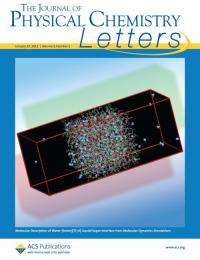Computer simulations give insights into how carbon dioxide reacts with a sequestering liquid

(PhysOrg.com) -- Worse than toddlers on a sugar high, carbon dioxide molecules just don't like standing still. The tiny molecules, just three atoms, leap from place to place in less than a trillionth of a second. Yet, scientists at Pacific Northwest National Laboratory and the University of Wisconsin-Parkside found a way to get clear pictures. They used computer simulations to get detailed images of carbon dioxide reacting with an ionic liquid's surface. The images show that the surface's molecular strata increases the energy needed for the gas to move into the liquid. They also found that carbon dioxide and water molecules arrange themselves differently once these molecules get close to the surface, based on how the molecule's electrons are spaced.
This work by Dr. Liem X. Dang and Dr. Tsun-Mei Chang is featured in an invited perspectives article in The Journal of Physical Chemistry Letters. A perspective article provides state-of-the-art research on new and emerging areas by leaders in the field. An image from the team's study graced the journal's cover.
While it might seem like an esoteric topic, useful only to those who inhabit ivory towers, understanding how gases interact with a liquid surface influences a lot, including the air we breathe and the energy we use. For example, coal-fired power plants produce large amounts of carbon dioxide. Scientists and industry leaders want to remove that dioxide and prevent its access to the environment. One option is to pump the gas through a liquid that traps only the carbon dioxide, and not other gases. But to do it, scientists must know how the gas interacts with the liquid's surface.
"If we want to optimize gas sorption, we must understand the interface, because most of the chemical and physical processes usually occur at the interface," said Dang.
When the reaction speed is measured in trillionths of a second and at scales measured in the width of atoms, scientists turn to powerful computer simulations to understand what is happening. The simulations allow them to freeze the action and gather accurate data. The researchers focused on gaseous carbon dioxide and a more hydrophobic or water-fearing room-temperature ionic liquid (see sidebar) known as [bmim][Tf2N].
The accuracy of that data depends in part on how well the molecular interactions, molecular orientation and surface tension are described. The research duo began by thoroughly examining the models, creating accurate portrayals.
Then, the team ran a series of simulations and examined how the gas and the liquid interacted. They found the solubilities of gases are critically dependent on the type of anions or negatively charged ions used to construct the ionic liquids.
"Solubilities are an active research subject in the ionic liquids field," said Dang.
The results raise questions about whether or not polarizable models are needed to simulate ionic liquids. This and questions about the influence of different charged particles in the liquid are being studied by the researchers.
More information: LX Dang and TM Chang. 2012. "Molecular Mechanism of Gas Adsorption into Ionic Liquids: A Molecular Dynamics Study." The Journal of Physical Chemistry Letters 3(2): 175-181. DOI: 10.1021/jz2011786
Provided by Pacific Northwest National Laboratory


















